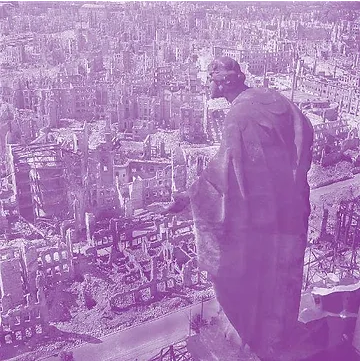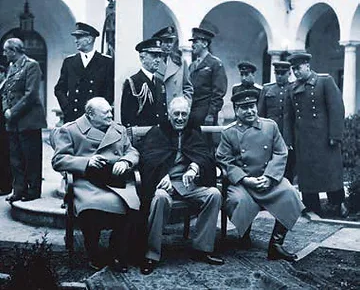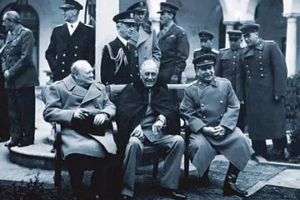This week in history — Though the Allies had driven the Germans from France, they bogged down along the fortifications that guarded the German fatherland. By mid-October 1944, the allies had taken Aachen, Metz, and Strasbourg; in November and early December, fierce German resistance halted their advance into the Saar region.
For fear of unconditional surrender (a policy that Pope Pius XII had asked the Allies to abandon because it would unduly lengthen the war) and Allied vengeance, the Germans put up the stubborn defense of despair.

German resistance broke in mid-December. In the Battle of the Bulge, the German army had assaulted Allied lines around Bastogne; but by December 26 Allied reinforcements saved Bastogne with heavy losses to the Germans.
Dresden bombing
In late January 1945, the Allies resumed their advance to the Rhine while the Russians pushed against the Germans in the East.
To hamper German troop movements, the Allies decided to bomb eastern German cities. B-29s assaulted Dresden, a city with no military significance, no anti-aircraft defenses, but filled with hundreds of thousands of war refugees. On February 13, 1945, Allied planes dropped incendiary bombs that ignited firestorms that laid waste the city. Three hours later came more B-29s and more incendiary bombs. The fires that consumed Dresden claimed an estimated 25,000–35,000 lives. (Earlier estimates were much higher, claiming 135,000 or more victims of the bombing.)
The Yalta Conference

While the British and Americans were still trying to cross the Rhine, the Red Army had reached Berlin. On February 3, Stalin, however, delayed the Russian assault on the German capital until after he met with Roosevelt and Churchill. They were to meet the next day at Yalta, on the Black Sea, to discuss the future of Europe after the war.
Stalin was a powerful broker at Yalta, for the Allied war effort depended on him. His army of 12 million men was three times the size of Eisenhower’s army. The Red Army’s engagement of 125 to 200 German divisions on the Eastern Front had kept them from reinforcing German troops on the Western Front.
Stalin and Churchill had met previously, in 1944, to discuss how they would divide Eastern Europe into “spheres of influence” between Russia and Great Britain. This meant that some parts of Eastern Europe would be dominated by Communists and others by “free” institutions. Roosevelt objected to this deal but did nothing to hinder it. Stalin was too important an ally to alienate.
At Yalta, Churchill and Roosevelt gave in to more of Stalin’s demands. Roosevelt wanted Stalin’s assurance that he would back an international organization called the United Nations.
Stalin said he would back the organization, but he had his price: three votes in the United Nations, the regulation of the formation of the government of liberated Poland, and the right to the use of forced German labor for 10 years after the war. Stalin promised to enter the war against Japan, but in return he wanted control of the Manchuria railroad and naval bases in the Far East.
Yalta, thus, set the stage for Soviet influence in the post-war world.
Discovering Nazi concentration camps, Hitler dies
In late March 1945, the Allied armies at last began crossing the Rhine into the heart of Germany. Marching through Bavaria in the south, the Allies were discovering the concentration camps where Nazis had imprisoned Jews and Gypsies, along with Germans, including Catholic and Protestant clergy, who had opposed the Nazi regime. 
Allied armies moved to the Elbe, west of Berlin, while the Russians attacked Berlin itself. On April 30, Adolf Hitler committed suicide and, soon after, the Russians captured the German capital.
When the new head of the German government, Admiral Doenitz, asked Eisenhower to discuss surrender with him, he was told that he had to surrender to the Russians, for it was they who captured Berlin.
On May 7, three days after the Allies crushed all German resistance in Italy, the German government signed an agreement of unconditional surrender with the Allies. The war in Europe had ended.
A Full-circle Moment at the Opera
Among the monuments utterly destroyed—only the shell was left standing—by the bombing of Dresden was the Semperoper, the opera house of the Saxon State Opera. (The house is named for Gottfried Semper, the architect who built it in 1841 and rebuilt after a fire devastated it in 1869.)
Carl Maria von Weber’s 1821 opera, Der Freischütz, was the last work performed in the Semperoper before the bombing. Forty years later, the same opera graced the house’s reopening on February 13, 1985.
Here is a performance in the Semperoper of Der Freischütz by the Staatskapelle Dresden, under the direction of Gustav Kuhn.
RELATED RESOURCES:
- Catholic Textbook Project — History books so exceptional that college professors say “students who study from these textbooks will enter college knowing more about history than most of their peers and some of their professors!”





You must be logged in to post a comment.